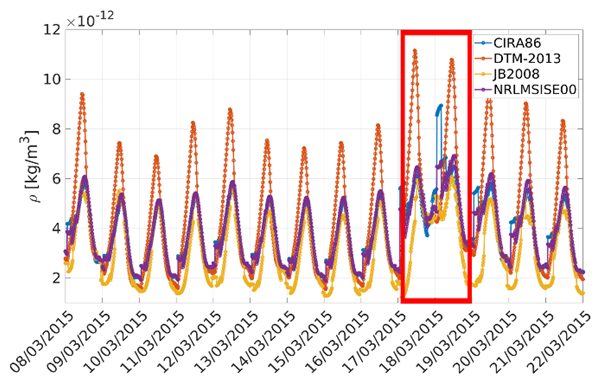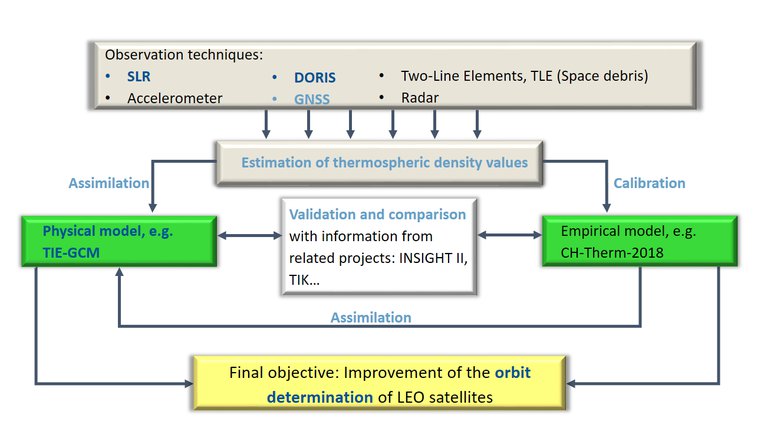Development of High-precision Thermosphere Models for Improving Precise Orbit Determination of Low-Earth Orbiting Satellites (TIPOD)

The project TIPOD is funded by the German Research Foundation (DFG) within the framework of the 2nd phase of the Special Proirity Programme (SPP) 1788 Dynamic Earth.
A major problem in the precise orbit determination (POD) of Low-Earth Orbiting (LEO) objects such as satellites or space debris is modeling the non-gravitational perturbation, in particular the atmospheric drag acceleration – mainly depending on the thermospheric density usually calculated from empirical models driven by globally defined space weather parameters such as the F10.7 index reflecting the solar activity.
Investigations at DGFI-TUM showed that these models provide rather different values, in particular during strong space weather events. Figure 1 shows the behavior of the neutral density computed from the 4 empirical models CIRA86, DTM-2013, JB2008, and NRLMSISE00 during the St. Patrick Event (red box). Due to partly large correlations regarding the thermospheric density the Keplerian elements could be considerably affected by the chosen empirical model. Therefore, an improvement of the thermosphere models for POD is absolutely necessary. This goal shall be reached within TIPOD by assimilating data from various satellite tracking techniques into the physical thermosphere-ionosphere coupling model TIE-GCM. In a first step, an empirical model will be interposed between the observations and the physical model. After calibrating the empirical model to the input data, its output will be assimilated into the physical model (see Figure 2). TIPOD will address two main scientific questions: (1) how close can the physical model recover the empirical one within the investigated time span of recent satellite missions such as CHAMP, GRACE, and Swarm, and (2) how far can the LEO-POD be improved by the application of both models? For the realization of a POD of LEO satellites, DGFI-TUM’s software package "DOGS" (DGFI-TUM Orbit and Geodetic parameter estimation Software) will be used.

During the project DGFI-TUM will focus on:
- Computation of thermospheric densities for LEO satellites using SLR, DORIS and GNSS tracking data including a complete stochastic model, consideration of correlations and uncertainties/quality of macro models
- Combination of all data sets to create a common data base of thermospheric densities
- Intensive investigations to understand the individual modules of TIE-GCM (e.g. for solar input, ionization rates, dissociation rates or heating rates) and the implementation of parameter calibration/data assimilation into TIE-GCM
- Comparison and validation of the model outputs with results from other projects (internal and external to the SPP 1788)
Selected Publications
Arcisstraße 21
80333 München